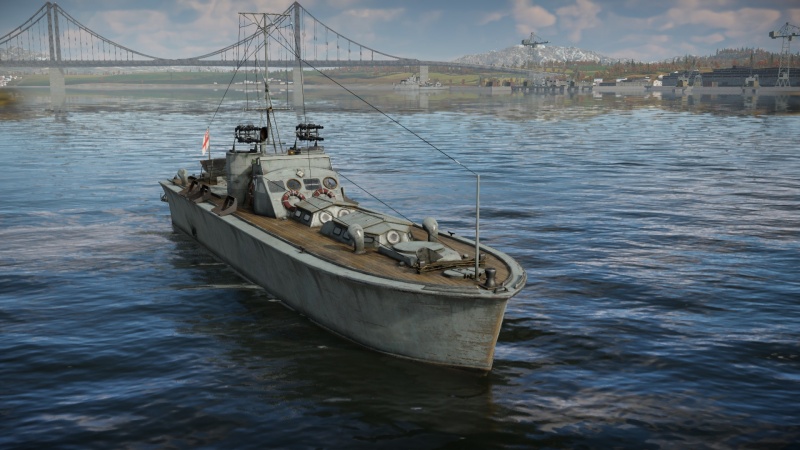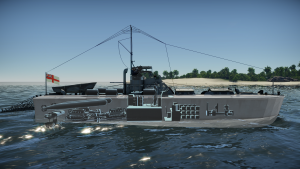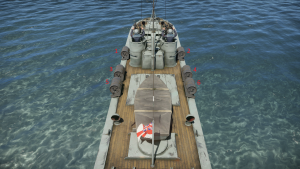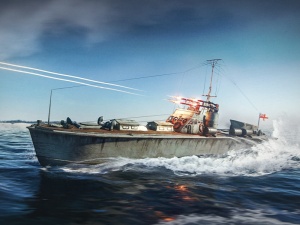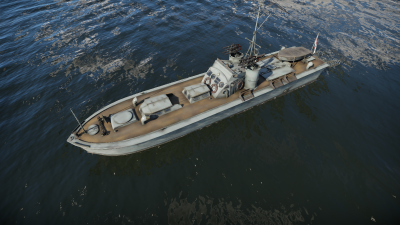MTB-1(2)
| This page is about the British motor torpedo boat MTB-1(2). For other versions, see MTB-1 (Family). |
Contents
Description
The MTB-1 2 series is a premium rank British motor torpedo boat with a battle rating of (AB), (RB), and (SB). It was introduced in Update 1.85 "Supersonic". With the split of the naval tech trees in Update "New Power", MTB-1(2) was moved to the coastal fleet tech tree.
The MTB-1(2) is as a premium variant of MTB-1(1), the reserve vehicle of the British coastal fleet tech tree. Largely similar to MTB-1(1), MTB-1(2) differs in the amount of depth charges that she can carry as well as the placement of the gun mounts, the latter being particularly important as the better firing angles gives MTB-1(2) some extra versatility in combat.
General info
Survivability and armour
MTB-1(2) has the following armour layout:
- Hull: 24 mm, wood
- Superstructure: 2 mm, steel
Any gun in the game will easily be able to penetrate the hull and superstructure at any practical range.
The hull is split into three sections. Starting from the bow and working towards the stern, the first section starts at the bow and ends after the ammunition storage; the second ends just behind the bridge; and the third ends at the stern.
MTB-1(2) can be hull-broken by any round with a large enough diameter and explosive mass. In general, this is limited to HE rounds greater with a diameter greater than or equal to 4 inches (102 mm) with an explosive mass greater than 1.5 kg. At MTB-1(2)'s own battle rating, there is only one gun capable of hull-breaking her:
- the 114 mm 8cwt QF Mk I, found on Dark Adventurer.
There is one ammunition storage that holds ammunition for both the fore and aft gun turrets. It is located directly behind the forward gun turret just above the waterline. Destroying it will instantly destroy MTB-1(2).
MTB-1(2) has a crew complement of 11. With a stock crew, it is knocked out when 7 crew are lost; with an aced crew, this is increased to 8.
While MTB-1(2)'s crew complement is about average when comparing vessels of the same battle rating, her overall survivability is rather poor when compared to everything in her battle rating range. The placement of the guns does allow MTB-1(2) to bow-tank without sacrificing firepower. However, due to the distribution of the crew, bow-tanking does not increase the survivability nearly as much as it does with some other vessels, so it is not a very viable tactic with MTB-1(2). With an aced crew and no prior damage, destroying only the components possible to hit from the front — the bow section, the bridge, and both gun turrets — already eliminates enough crew to prevent MTB-1(2) from repairing. Either doing slight damage to any of the other hull sections or destroying the bridge again when it is automatically repaired is enough to knock out MTB-1(2).
Mobility
| Mobility Characteristics | |||||
|---|---|---|---|---|---|
| Game Mode | Upgrade Status | Maximum Speed (km/h) | Turn Time (s) | Turn Radius (m) | |
| Forward | Reverse | ||||
| AB | Stock | 63 | 32 | ~18.64 | ~35.43 |
| Upgraded | ~12.67 | ~22.41 | |||
| RB/SB | Stock | 53 | 26 | ~20.77 | ~36.73 |
| Upgraded | ~17.44 | ~33.15 | |||
While her top speed is on the slower side compared to other motor torpedo boats, MTB-1(2)'s manoeuvrability is actually rather good. With a tight turning circle and a decent enough top speed, the mobility is suitable enough for most situations, although the lower top speed really hurts her potential for flanking on certain maps.
MTB-1(2) has a displacement of 22.4 tons. Because of her small size and relatively low displacement, MTB-1(2) can be an unstable firing platform in rough waters.
Modifications and economy
As a premium vehicle, all modifications are unlocked for free.
Armament
Primary armament
The primary armament consists of eight 7.72 mm Lewis 1916 machine guns in two quadruple mounts, one on the bow and one on the stern. There are 3,880 rounds of ammunition available for each mount, 970 rounds per gun, for a total of 7,760 rounds. Stock, the mounts can traverse horizontally and vertically at a rate of 64°/s; with the "Primary Armament Targeting" modification installed, this is increased to 75°/s. Each gun has a magazine capacity of 97 rounds and a cyclic rate of fire of 551 rounds/min. With a stock crew, the guns can be reloaded in 18.2 seconds; with an aced crew, they can be reloaded in 14 seconds. The 7.72 mm Lewis 1916 machine gun has an absolute maximum range of about 1.7 km against surface targets.
The 7.72 mm Lewis 1916 machine guns, like other low-calibre machine guns, each individually have very poor damage outputs. With their relatively large magazine size and eight of them in total, though, MTB-1(2) is able to destroy most opponents without needing to reload, assuming that most of the shots land, especially at closer range (500 m or less) where the shot will mostly penetrate and deal a considerable damage. This, however, comes at the cost of an incredibly long reload, the longest of any reserve vessel and one of the longest of any coastal fleet vessel in general. Because of this, it's best to always fire off any remaining ammunition after engagements to begin reloading in safety and to ensure full magazines at the start of the next engagement.
| Turrets are named sequentially, clockwise, starting at the bow |
| Primary armament guidance | |||
|---|---|---|---|
| No.1 Turret (starboard) | No.2 Turret (port) | ||
| Horizontal | Vertical | Horizontal | Vertical |
| ±180° | -5°/+43° | ±180° | -5°/+43° |
Both gun mounts are able to fire in all directions except for a ~47° arc in the direction of the opposite mount. Both gun mounts are able to fully rotate 360°.
There are three ammunition types available:
- Universal: AP · T · AP · T
- 7.7 mm AP belt: AP · AP · AP · T
- 7.7 mm API belt: IT · IT · IT · IT
| Penetration statistics | |||||||
|---|---|---|---|---|---|---|---|
| Ammunition | Penetration @ 0° Angle of Attack (mm) | ||||||
| 10 m | 100 m | 500 m | 1,000 m | 1,500 m | 2,000 m | ||
| AP | 10 | 9 | 7 | 6 | 4 | 3 | |
| T | 9 | 8 | 6 | 5 | 3 | 2 | |
| IT | 10 | 9 | 7 | 5 | 4 | 3 | |
| Shell details | ||||||||||||
|---|---|---|---|---|---|---|---|---|---|---|---|---|
| Ammunition | Velocity (m/s) |
Projectile mass (kg) |
Fuse delay (m) |
Fuse sensitivity (mm) |
Explosive mass (TNT equivalent) (g) |
Ricochet | ||||||
| 0% | 50% | 100% | ||||||||||
| AP | 853 | 0.01 | - | - | - | 47° | 56° | 65° | ||||
| T | 835 | 0.01 | - | - | - | 47° | 56° | 65° | ||||
| IT | 920 | 0.01 | - | - | - | 47° | 56° | 65° | ||||
While the armour-piercing round and the incendiary tracer round deal about the same amount of the damage, the standard tracer round deals incredibly little damage to both surface targets and aircraft. Because of this, the AP belt is a strict upgrade from the default belt. Compared to the AP rounds, the IT rounds also have a much higher muzzle velocity. Altogether, this makes the API belt the best overall, due both to its lack of standard tracer rounds and better ballistic properties.
Additional armament
MTB-1(2) can be outfitted with the following:
- 2 x Mk.XII torpedo
- 6 x Mk.VII depth charge
- 2 x Mk.XII torpedo, 6 x Mk.VII depth charge
- Without load
Torpedoes
MTB-1(2) can carry two 18 inch Mark XII torpedoes. These are carried internally in the aft of the boat and are launched through the transom tail first, i.e. facing forwards.
| Torpedo characteristics | ||||||||
|---|---|---|---|---|---|---|---|---|
| Torpedo Mode | Mass (kg) | Maximum speed in water (km/h) | Travel distance (km) | Depth stroke (m) | Arming distance (m) | Explosive type | Explosive mass (kg) | TNT equivalent (kg) |
| No | 702 | 50 | 3.20 | 1 | 50 | TNT | 176 | 176 |
| Yes | 702 | 74 | 1.37 | 1 | 50 | TNT | 176 | 176 |
The 18-inch Mk.XII is fairly average in terms of maximum speed, though it has a rather short maximum range and small explosive mass compared to other torpedoes. Still, the range is good enough for coastal maps, and a hit with the Mk.XII torpedo is more than enough to destroy any boat.
Since it's unlocked from the start, it's best to always keep Torpedo Mode installed. The maximum speed of a torpedo is more valuable in coastal battles than its maximum range. Coastal fleet maps are also small enough that the decreased range with Torpedo Mode installed isn't much of an issue. Note, though, that the Torpedo Mode modification on MTB-1(2) has the opposite effect compared to most other vessels. Typically, the maximum range is increased at the cost of speed.
In RB, always set the depth stroke to the minimum 1 m setting. This is because many vessels that MTB-1(2) can face will not have a deep enough draught to fuse the torpedo at a depth stroke setting of 4 m. In AB, depth stroke is automatically set to the most optimal setting.
When using torpedoes, be aware that unless they are already launched, the torpedoes be shot at and destroyed. Upon being destroyed, there is relatively high chance for them to detonate, instantly destroying the boat. To avoid this, fire the torpedoes early on in battle — as well as after any subsequent reloads in AB — or simply don't take them at all. Torpedoes are a situational weapon, so it's largely down to personal preference whether or not to take them.
Depth Charges
The Mk.VII depth charges are carried around the bridge area, three on each side. They are dropped one at a time in the following order:
- Port, foremost
- Starboard, foremost
- Port, centre
- Starboard, centre
- Port, aftmost
- Starboard, aftmost
Before spawning, the detonation time delay can be set anywhere between 3 seconds and 10 seconds.
| Depth charge characteristics | ||||||
|---|---|---|---|---|---|---|
| Mass (kg) | Explosive type | Explosive mass (kg) | TNT equivalent (kg) | HE armour penetration (mm) |
Armoured vehicle destruction radius (m) |
Fragment dispersion radius (m) |
| 196 | TNT | 130 | 130 | 101 | 8 | 122 |
There is almost no practical reason to use depth charges on any naval vessel in the game. Although they usually result in a one-hit kill if used properly, they are extremely situational, requiring the player to close to point-blank ranges to even use them. In almost every case, anytime a depth charge could be used, the guns or torpedoes can be used instead to greater effect. In fact, depth charges tend to actually be a liability in battle, since they essentially act as exposed ammo racks before they're dropped. Like torpedoes, they can be shot at, and if destroyed, they have a chance to detonate, instantly destroying the boat.
Despite this, some success can be had in dropping them either next to, or in front of a large, slow target. If dropping them next to the target, remember the depth charge drop order, since it's most likely that only the depth charges dropped on the side closest to the enemy will deal any damage. If dropping in front of the target, rush in from the sides as quickly as possible and drop them all at once directly in front of the target. For both cases, set the depth charge time delay to the minimum 3 seconds, since any higher time delay will only allow the depth charge to sink further away from the target, giving them more time to move out of the way. Again, using depth charges is extremely situational, and they will only be a liability the vast majority of the time, so take them at your own discretion.
Usage in battles
MTB-1(2) is largely identical to her tech tree equivalent, MTB-1(1). As such, she shares many of the same drawbacks — low per-hit damage, low maximum range, and generally poor survivability — although with one key difference: while the gun turrets are mounted on the fore and aft on MTB-1(2), they are mounted side-by-side amidships on MTB-1(2). This arrangement allows MTB-1(2) extra versatility over MTB-1(2), since all of the guns can now be brought on target without needing to angle the hull. Aside from this, though, MTB-1(2) has much the same playstyle as MTB-1(1).
Like MTB-1(1), the limitations of the guns dictate MTB-1(2)'s playstyle. The 7.7 mm Lewis machine guns have poor ballistic qualities and a absolute maximum range of only about 1.7 km. Because of this, stick to close-range engagements, ideally within 1 km, and avoid open areas of the map wherever possible. Additionally, the guns have a very low per-hit damage output, so avoid direct confrontations as much as possible. Instead, use MTB-1(2)'s decent top speed to rush into flanking positions or contested areas around capture points, making use of hard cover to play a supportive role, assisting your teammates in taking down preoccupied enemies. For larger targets unaffected by the guns, mark their position on the map for your team and call artillery.
Another thing to be aware of is the extremely long reload of the guns. Running out of ammo mid-engagement will always always lead to MTB-1(2)'s destruction, so at all times, keep an eye on how much ammunition is left in the guns and try to always keep an escape route open, using smoke to run away if necessary. In general, but especially for guns with long reloads, it's a good idea to be proactive with the reloads. Before the magazines empty, run back to cover, then fire off any remaining ammunition in order to start reloading in safety. A good time to consider doing this with MTB-1(2) is when the magazines about half empty, or when it shows about 750 rounds left between all guns, since with any less ammo, it may be difficult to finish an engagement before needing to reload. However, do be aware that MTB-1(2) can, at most, only carry enough ammunition for 10 reloads. This doesn't tend to be much of an issue in practice because MTB-1(2) doesn't tend to survive long enough for it to become an issue, but it is something to keep in mind.
As for torpedoes, either launch them down choke points or prioritize larger, slower targets such as sub-chasers that the guns are ineffective against. If targeting a specific enemy, try to launch them as close to the target as possible to allow them the least amount of time to dodge. However, try to only do this on distracted targets and when other enemies aren't around, since exposing MTB-1(2) to enemy fire just to launched the torpedoes is generally not worth the risk. If the situation doesn't present itself, it's better to just mark the target on the map for your teammates, call artillery, then disengage. As mentioned in the previous section, torpedoes are a situational weapon, and taking them at all negatively impacts survivability, so only take them if you prefer the extra utility at the cost of survivability.
Pros and cons
Pros:
- Relatively large magazine capacity: can destroy most opponents without needing to reload
- Numerous guns offer high burst damage at point blank range (~500 m)
- Better gun coverage compared to its tech tree counterpart
- Good manoeuvrability
Cons:
- Only armed with low-calibre guns: very poor overall damage output and limited effective range
- Very long reload: longest of any reserve and one of the longest among coastal vessels
- Poor survivability
- Relatively weak torpedoes: low explosive mass compared to other similar torpedoes
History
Though the Royal Navy had operated a small number of coastal boats during the first World War, by the 1930s, these flotillas had long been dissolved and the Royal Navy had yet to construct any more. The first two coastal boats since WWI were ordered on 27th September 1935 by the Royal Navy, the order being given to British Power Boat Company based at Hythe, a town near Southampton. In addition to this initial order, four more were ordered on 19th October 1935. These six boats were completed by November 1936, and, with their commissioning on 27th April 1937, the Royal Navy Coastal Forces was founded. Following this, three more boats were ordered on 7th December 1936 and nine more on 11th January 1938. In total, 18 boats were ordered, all of them being completed by 1939.
These boats had a standard displacement of 18 tons and had a length of 60 ft. 4 in., a width of 13 ft. 4 in., and a draught of 2 ft. 10 in. at standard displacement. They were powered by three Napier Sea Lion petrol engines, each driving a single shaft, and could reach speeds of around 30-35 knots. Each boat could carry two 18 inch torpedoes which were stored internally on rails above the engines. On the stern were two more rails that could be folded down to the transom, extending the torpedoes' rails outside of the boat. The torpedoes fired facing forwards down the rails, after which the boat that fired them would have to turn to evade their path. In addition to torpedoes, the boats were also armed with a number of depth charges and, depending on the exact boat, up to eight Lewis guns.
MTB 1, the first of the boats, was redesignated MTB 7 in 1937. Similarly, MTB 7 was redesignated MTB 1 in the same year. In 1938, the former MTB 1, now MTB 7, was redesignated MTB 13. At the same time, MTB 13 was redesignated MTB 7. Finally, later in 1938, the former MTB 1, now MTB 13, was again redesignated MTB 19. Thus, by the start of WWII, the boats were numbered MTBs 1-12 and 14-19 and formed two MTB flotillas: 1st MTB Flotilla, consisting of MTBs 1-6 and 14-19; and 2nd MTB Flotilla, consisting of MTBs 7-12.
The 1st MTB Flotilla was sent to the Mediterranean at the start of WWII and was based at HMS Vulcan in Malta. They were soon recalled back to England in December 1939 to be based at HMS Beehive, Felixstowe, though MTB 19 was sent to HMS Vernon, Portsmouth. Along the way back, due to bad weather, MTB 6 had to be foundered. After they arrived, the remaining boats continued to operate in the English Channel until they were either lost or replaced. Those lost were MTBs 15, 16, and 17, all of which were mined in 1940.
The 2nd MTB Flotilla was commissioned in 1938 and assigned to HMS Tamar, Hong Kong. They were all lost during the Battle of Hong Kong in December 1941. MTB 8 was bombed by IJN aircraft and was damaged beyond repair, and MTB 12 was sunk in action by IJN landing craft. The remainder of the 2nd MTB Flotilla was scuttled on 26th December 1941.
Media
- Skins
- Images
See also
- Vehicles of the same class
- Similar vehicles
External links
- [Unit Histories] Royal Navy Coastal Forces 1940-1945
- [naval-history.net] British vessels lost at sea in World War 2 - MGB, MTB, SGB, ML, etc - originally published in British Vessels Lost at Sea, 1935-45, His Majesty's Stationary Office, 1947
- [mwadui.com] Royal Navy Coastal Forces - Hong Kong
- [Coastal Forces Heritage Trust] Coastal Forces of World War II - History
- [yalumba.co.uk] British Power Boat Co Page 1
- [yalumba.co.uk] British Power Boat Co Page 5
- [Wikipedia] Coastal Forces of the Royal Navy
| British Power Boat Company | |
|---|---|
| Motor Torpedo Boat (MTB) | |
| 60 ft British Power Boat MTB | MTB-1(1) · MTB-1(2) |
| Motor Gun Boat (MGB) | |
| 70 ft British Power Boat MGB | MGB-61 |
| 71 ft British Power Boat MGB | MGB-75 |
| Britain boats | |
|---|---|
| Motor torpedo boats | Brave Borderer · Dark Aggressor · Dark Aggressor TD · Fairmile D (617) · Fairmile D (697) · Fairmile D (5001) · HMS Gay Archer |
| MTB-1(1) · MTB-1(2) · MTB Vosper · MTB Vosper(2) · MTB-422 | |
| Motor gun boats | Dark Adventurer · Fairmile A (ML100) · Fairmile B (ML345) · Fairmile C (312) · Fairmile C (332) · Fairmile D (601) · Fairmile H LCS(L)(2) |
| HMAS Arrow · HMAS Fremantle · MGB-61 · MGB-75 · ML 1383 · SGB Grey Fox · SGB Grey Goose | |
| Gunboats | HMS Spey |
| Britain premium ships | |
|---|---|
| Motor torpedo boats | MTB-1(2) · MTB-422 · Fairmile D (5001) · HMS Gay Archer |
| Motor gun boats | MGB-75 · SGB Grey Goose |
| Gunboats | HMS Spey |
| Sub-chasers | LÉ Orla |
| Frigates | HMS Whitby |
| Destroyers | HMS Montgomery · HMS Valhalla · HMS Verdun · ORP Garland · HMS Jervis · HMCS Haida · HMS Mohawk · HMS Cadiz · HMS Diamond |
| Light cruisers | HMS Belfast |
| Battleships | HMS Iron Duke |



